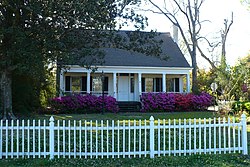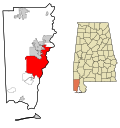Midtown Historic District | |
| Location | Roughly bounded by Taylor Ave., US 90, Houston St., Kenneth St., US 98, and Florida St., 2401-2403 and 2407 Old Shell Rd., Mobile, Alabama |
|---|---|
| Coordinates | 30°40′59.82″N88°5′19.44″W / 30.6832833°N 88.0887333°W |
| Area | 467 acres (189 ha) |
| Built | 1880s-1950s |
| Architect | George Rogers C.L. Hutchisson, Sr. C.L. Hutchisson, Jr. Nicholas Holmes, Jr. others |
| Architectural style | Greek Revival, Queen Anne, late Victorian, Spanish Colonial Revival |
| NRHP reference No. | 01001293 [1] (original) 100005805 (increase) |
| Significant dates | |
| Added to NRHP | 29 November 2001 [1] [2] |
| Boundary increase | November 18, 2020 |
The Midtown Historic District is a historic district in the city of Mobile, Alabama, United States. It was placed on the National Register of Historic Places on November 29, 2001, with a small boundary increase on November 18, 2020 [1] It is roughly bounded by Taylor Avenue, Government Street, Houston Street, Kenneth Street, Springhill Avenue, and Florida Street. [2] The district covers 467 acres (1.89 km2) and contains 1,270 contributing buildings. The majority of the contributing buildings range in age from the 1880s to the 1950s and cover a wide variety of architectural styles. [2] The district was significantly affected by a tornado on December 25, 2012. [3]









